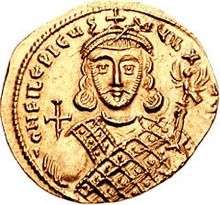Philippikos Bardanes
Philippikos or Philippicus (Greek: Φιλιππικός) was Emperor of the Byzantine Empire from 711 to 713.
| Philippikos | |
|---|---|
| Emperor of the Romans | |
 A solidus of Philippikos | |
| Emperor of the Byzantine Empire | |
| Reign | 11 December 711– 3 June 713 |
| Predecessor | Justinian II |
| Successor | Anastasius II |
| Died | 713 |
| Father | Nikephorus |
| Twenty Years' Anarchy | |||
|---|---|---|---|
| Chronology | |||
|
|||
| Succession | |||
|
|||
Biography
Philippicus was originally named Bardanes (Greek: Βαρδάνης, Vardanis; Armenian: Վարդան, Vardan); he was the son of the patrician Nikephorus, who was of Armenian extraction from an Armenian colony in Pergamum.[1]
Relying on the support of the Monothelite party, he made some pretensions to the throne on the outbreak of the first great rebellion against Emperor Justinian II; these led to his relegation to Cephalonia by Tiberius Apsimarus, and subsequently to his banishment to Cherson by order of Justinian. Here Bardanes, taking the name of Philippicus, successfully incited the inhabitants to revolt with the help of the Khazars. The successful rebels seized Constantinople, and Justinian fled; Philippikos took the throne. Justinian was subsequently seized and beheaded; his son Tiberius was likewise apprehended by Philippikos's officers, Ioannes and Mauros, and killed in a church. Justinian's principal officers, such as Barasbakourios, were also massacred.
Reign
Among his first acts were the deposition of the orthodox patriarch Cyrus of Constantinople, in favour of John VI, a member of his own sect, and the summoning of a conciliabulum of Eastern bishops, which abolished the canons of the Sixth Ecumenical Council. In response the Roman Church refused to recognize the new Emperor and his patriarch. Meanwhile, Tervel of Bulgaria plundered up to the walls of Constantinople in 712. When Philippicus transferred an army from the Opsikion theme to police the Balkans, the Umayyad Caliphate under Al-Walid I made inroads across the weakened defenses of Asia Minor.
In late May 713 the Opsikion troops rebelled in Thrace. Several of their officers penetrated the city and blinded Philippicus on June 3, 713 while he was in the hippodrome.[2] He was succeeded for a short while by his principal secretary, Artemius, who was raised to the purple as Emperor Anastasius II. He died in the same year.
See also
Bibliography
- References
- Charanis, Peter (1959). "Ethnic Changes in the Byzantine Empire in the Seventh Century". Dumbarton Oaks Papers. Dumbarton Oaks. 13: 23–44. doi:10.2307/1291127. JSTOR 1291127.
- Theophanes 1982, p. 79.
- Sources
- Ostrogorsky, George (1956). History of the Byzantine State. Oxford: Basil Blackwell.CS1 maint: ref=harv (link)
- Theophanes; Translated by Harry Turtledove. The Chronicle of Theophanes: an English translation of anni mundi 6095–6305 (A.D. 602–813) (1982 ed.). University of Pennsylvania Press. ISBN 0-8122-1128-6.

Further reading
- The Oxford Dictionary of Byzantium, Oxford University Press, 1991.
External links

Philippikos Bardanes Years of Anarchy Born: ? Died: 713 | ||
| Regnal titles | ||
|---|---|---|
| Preceded by Justinian II |
Byzantine Emperor 11 December 711 – 3 June 713 |
Succeeded by Anastasius II |